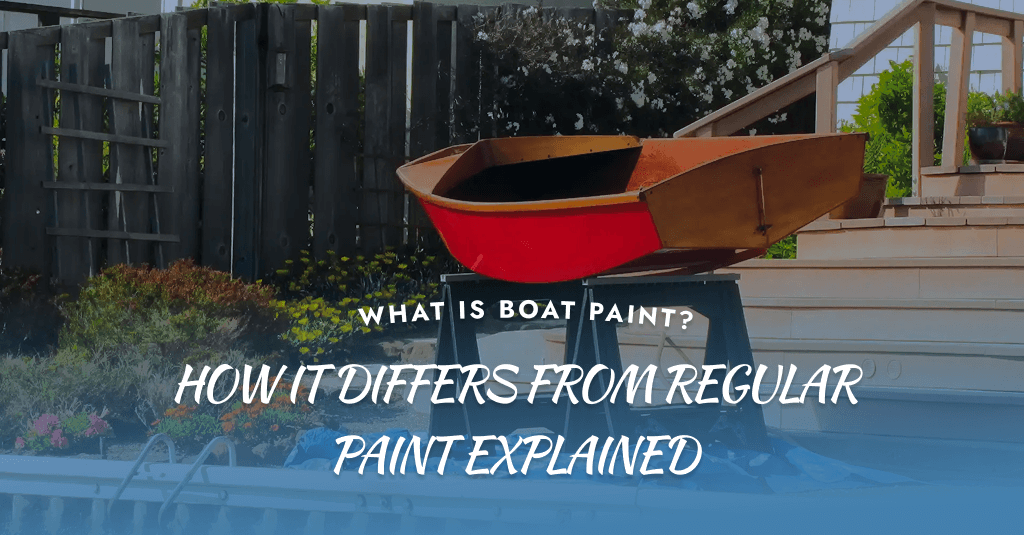
What is Boat Paint? How it Differs from Regular Paint Explained
Paint is more than just a coat of color especially when it comes to protecting boats. If you’re new to marine maintenance or shopping for a repainting service, you’ve probably wondered: what exactly is boat paint, and how does it differ from regular paint? These are not interchangeable products. The marine environment introduces a unique set of challenges like salt exposure, constant moisture, and UV degradation that regular paints simply aren’t designed to withstand.
In this comprehensive guide, we’ll explore what makes boat paint essential, how it differs chemically and functionally from everyday paints, and why using the right marine coating is critical for the longevity of your vessel.
What Is Boat Paint?
Boat paint is a specially formulated coating designed to protect boats from the harsh marine environment. It serves multiple purposes, including corrosion resistance, fouling prevention, waterproofing, and UV protection. Depending on the area being painted whether it’s the hull, deck, or bottom different types of marine coatings are used.
Boat paints are generally categorized into:
-
Topside Paints: Used above the waterline (e.g., decks and cabins).
-
Bottom Paints (Antifouling): Used below the waterline to prevent marine growth.
-
Epoxy Primers and Sealers: Used for surface preparation and added durability.
These products contain marine-grade resins, additives, and pigments that are far more resistant to weathering and chemical degradation than what you’d find in typical household or automotive paints.
Why Not Use Regular Paint on Boats?
Regular paints are made for surfaces that don’t face saltwater, high UV exposure, or constant moisture. While they might look good initially, they quickly degrade in marine conditions. Here’s why:
1. Water Resistance
Standard wall or automotive paints are not waterproof. When exposed to continuous splashing or submersion, they can peel, blister, or become moldy. Boat paint, on the other hand, is specifically designed to repel water and prevent osmosis damage especially on fiberglass hulls.
2. UV Protection
Regular paints may contain limited UV resistance, which leads to fading or chalking when exposed to the sun. Marine coatings, especially topside paints, contain UV blockers that protect against intense solar exposure.
3. Fouling Prevention
Below the waterline, marine organisms such as barnacles, algae, and slime readily attach to untreated surfaces. Antifouling paint contains biocides like copper that inhibit the growth of such organisms. Regular paint has no such functionality.
4. Adhesion Strength
Boat paint is engineered to bond tightly with marine materials like gelcoat, fiberglass, aluminum, and marine plywood. Regular paints might not even adhere properly, leading to premature peeling.
Types of Boat Paint
Understanding the types of marine coatings helps clarify how tailored they are to specific marine uses.
• Topside Paint
Used above the waterline, topside paint is decorative and protective. It must be flexible to withstand expansion and contraction due to temperature changes, yet durable enough to handle sun, rain, and spray.
Popular options include:
-
Polyurethane – Known for its high gloss and UV protection.
-
Alkyd Enamel – Easier to apply, but less durable than polyurethane.
• Bottom Paint (Antifouling Paint)
Designed for use below the waterline, antifouling coatings prevent marine growth by using toxic agents like copper. There are two major types:
-
Hard Bottom Paint – Long-lasting, ideal for high-speed boats.
-
Ablative Paint – Wears away slowly, taking fouling with it.
• Epoxy Paint and Primers
These offer excellent corrosion protection and are often used on metal hulls or as a primer before applying other marine coatings. Epoxy systems are especially important in fiberglass boats to prevent water intrusion and blistering.
Key Ingredients That Make Boat Paint Unique
Let’s break down why boat paint holds up where regular paint fails:
-
Marine-Grade Resins: Epoxy, polyurethane, and vinyl resins provide adhesion, flexibility, and durability.
-
UV Stabilizers: Protect against sun-induced oxidation.
-
Biocides: Used in antifouling paints to prevent organic growth.
-
Plasticizers: Enhance flexibility, reducing the chance of cracking.
-
High-Solids Content: Increases thickness and protection without many coats.
All of these components work together to create a product that can handle the stress of being constantly in or near water.
Can You Use Regular Paint on a Boat?
Technically, yes but it’s highly discouraged. Regular paint may appear fine for a short period, but it can cause bigger issues down the line such as:
-
Mold and mildew growth.
-
Rust and corrosion (especially on metal boats).
-
Deterioration of underlying structure due to moisture seepage.
If budget is a concern, there are affordable marine-grade paints that offer basic protection without breaking the bank. Using a cheap regular paint will only lead to costly repairs or repainting in the long run.
What Surfaces Require Marine Paint?
Boat paint isn’t just for the hull. Different surfaces on a boat need different formulations:
-
Decks – Require anti-slip coatings and UV resistance.
-
Cabins/Interiors – Often need mildew-resistant and easy-to-clean coatings.
-
Engines/Metal Parts – Need corrosion-resistant enamel or epoxy coatings.
-
Bottom Hull – Needs antifouling protection.
Each area faces different stress factors, so using the correct type of marine coating is critical for overall vessel health.
Application Tips for Boat Paint
If you’re doing it yourself or working with a professional, follow these best practices:
-
Always clean and sand the surface before painting.
-
Apply marine primers on bare surfaces.
-
Follow the manufacturer’s recommended drying times.
-
Use proper safety gear, especially for antifouling paints containing copper.
Proper application ensures longevity and performance—cutting corners can cost more over time.
Long-Term Benefits of Using Boat Paint
Using the right marine-grade paint doesn’t just make your boat look better it improves:
-
Fuel Efficiency: A clean, smooth hull reduces drag.
-
Resale Value: A well-maintained boat with quality paint is worth more.
-
Longevity: Reduces the risk of costly repairs and water damage.
-
Safety: Enhanced visibility and protection against hull degradation.
Investing in quality coatings pays off both short- and long-term.
Common Myths About Boat Paint
“It’s the same as car paint.”
No. Marine conditions are far more severe. Boat paint must endure constant UV, salt, and water exposure.
“Antifouling is optional.”
Only for boats stored out of water. If you moor your boat, antifouling is essential to prevent marine growth.
“All boat paints are toxic.”
While antifouling paints do contain biocides, many topside and epoxy paints are low-VOC and safe when used properly.
Choosing the right paint for your boat isn’t just about aesthetics—it’s about performance, safety, and protection. Boat paint is specially engineered to handle the tough marine environment that regular paint simply can’t withstand. From resisting UV rays to preventing barnacle buildup, marine coatings are a vital part of your vessel’s health and longevity.
So next time you’re thinking about a touch-up or repainting project, remember that not all paints are created equal. Trust marine-grade formulations specifically crafted for the job, and your boat will thank you with smoother sails and fewer surprises.
Frequently Asked Questions (FAQs)
What is boat paint made of?
Boat paint is formulated with marine-grade resins like epoxy, polyurethane, or vinyl, along with UV stabilizers, biocides, and plasticizers. These components make it durable, waterproof, and resistant to salt, sun, and marine organisms—unlike regular paint which lacks such resilience.
Can I use regular paint on a boat if I’m not going into saltwater?
Even in freshwater, boats face constant moisture, UV exposure, and physical wear. Regular paint may peel, blister, or fade quickly. Using dedicated boat paint ensures long-term protection, even in lakes or rivers.
How often should boat paint be reapplied?
This depends on the type of paint and boat usage. Topside paint can last 2–5 years, while bottom (antifouling) paint may need to be reapplied annually or biannually, especially for boats that stay in the water year-round.
What’s the difference between topside and bottom boat paint?
Topside paint is applied above the waterline and focuses on UV protection and aesthetics. Bottom paint (antifouling) is used below the waterline to prevent marine growth. Each is specially designed for different environmental exposures.
Is boat paint safe for the environment?
Modern marine coatings, especially antifouling paints, contain biocides that can affect marine life. However, eco-friendly options with lower toxicity are available. It’s essential to choose environmentally responsible boat paint if local regulations require it.





